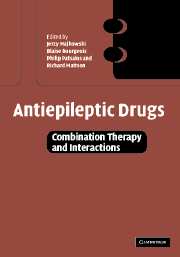Book contents
- Frontmatter
- Contents
- List of contributors
- Foreword
- Foreword
- Acknowledgements
- Part I Introduction
- Part II Pharmacokinetic interactions
- Part III Pharmacodynamic interactions
- Part IV Drug interactions in specific patient populations and special conditions
- 14 Antiepileptic drug interactions in children
- 15 Antiepileptic drug interactions in the elderly
- 16 Antiepileptic drug interactions in pregnancy
- 17 Antiepileptic drug interactions in handicapped and mentally retarded patients
- 18 Antiepileptic drugs and sex steroids
- 19 Antiepileptic drug interactions in patients requiring psychiatric drug treatment
- 20 Antiepileptic drugs in non-epileptic health conditions: possible interactions
- 21 Drug monitoring in combination therapy
- 22 Cognitive side-effects due to antiepileptic drug combinations and interactions
- Part V Conclusions and future perspectives
- Index
14 - Antiepileptic drug interactions in children
from Part IV - Drug interactions in specific patient populations and special conditions
Published online by Cambridge University Press: 07 September 2009
- Frontmatter
- Contents
- List of contributors
- Foreword
- Foreword
- Acknowledgements
- Part I Introduction
- Part II Pharmacokinetic interactions
- Part III Pharmacodynamic interactions
- Part IV Drug interactions in specific patient populations and special conditions
- 14 Antiepileptic drug interactions in children
- 15 Antiepileptic drug interactions in the elderly
- 16 Antiepileptic drug interactions in pregnancy
- 17 Antiepileptic drug interactions in handicapped and mentally retarded patients
- 18 Antiepileptic drugs and sex steroids
- 19 Antiepileptic drug interactions in patients requiring psychiatric drug treatment
- 20 Antiepileptic drugs in non-epileptic health conditions: possible interactions
- 21 Drug monitoring in combination therapy
- 22 Cognitive side-effects due to antiepileptic drug combinations and interactions
- Part V Conclusions and future perspectives
- Index
Summary
Introduction
Many clinical practitioners are of the opinion that the optimal treatment of epilepsy is best achieved by use of antiepileptic drugs (AEDs) that have several modes of action, and therefore the drugs that are the most effective in this regard are AEDs such as carbamazepine (CBZ), valproate (VPA) or topiramate (TPM) whose efficacy relates to several modes of action. Thus, from the pharmacodynamic point of view, these AEDs when prescribed as monotherapy in fact comprise polytherapy regimens. On the other hand, because of metabolism, many AEDs reach the brain as combinations of the parent drug and their metabolite(s) and this too can be considered a form of polytherapy. For example, CBZ, which is metabolized to a pharmacologically active metabolite CBZ-epoxide, readily enters the brain where it exerts pharmacological effects. Thus polytherapy at the brain level can in fact be distinguished from polytherapy at the oral level. The same applies to clobazam (CLB) whose metabolism is inhibited by stiripentol leading to significant increase of CLB and norCLB with far better tolerability (Perez et al., 1999; Chiron et al., 2000). This is also observed with VPA for which the proportion of toxic 4-ene-VPA is decreased (Levy et al., 1987). A further consideration is that the metabolic pathway may vary according to age. Therefore, in infants, the hydroxylation of both diazepam and nordiazepam is very limited, combined with low glucoronidation capacity which generates major hypotonia (Morselli et al., 1973).
Keywords
- Type
- Chapter
- Information
- Antiepileptic DrugsCombination Therapy and Interactions, pp. 257 - 272Publisher: Cambridge University PressPrint publication year: 2005



